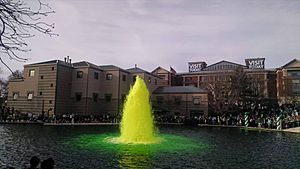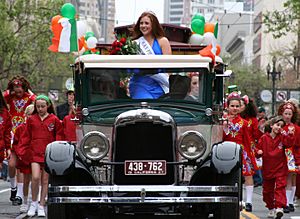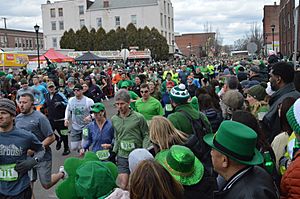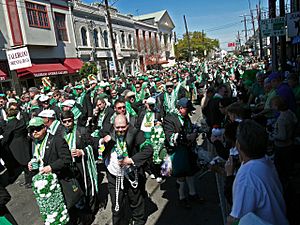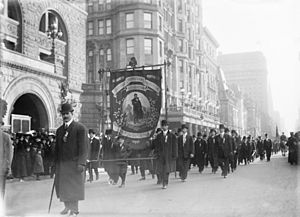Saint Patrick's Day in the United States facts for kids

Saint Patrick's Day is a special day celebrated across the United States. Even though it's only a legal holiday in a few places like Savannah, Georgia and Suffolk County, Massachusetts, many people celebrate it! It's a day to honor Irish and Irish American culture. People celebrate by wearing lots of green, enjoying special foods and drinks, going to religious services, and watching big parades. People in what is now the U.S. have been celebrating this holiday since 1601.
In 2016, people in the United States spent about $4.4 billion on Saint Patrick's Day.
Contents
- How Did It Start?
- Fun Traditions Today
- Big Parades Across the Country
- Atlanta, Georgia
- Baltimore, Maryland
- Boston, Massachusetts
- Buffalo, New York
- Butte, Montana
- Chicago, Illinois
- Cleveland, Ohio
- Columbia, South Carolina
- Dallas, Texas
- Detroit, Michigan
- Dublin, California
- Enterprise, Alabama
- Holyoke, Massachusetts
- Hot Springs, Arkansas
- New Orleans
- New York City
- Omaha, Nebraska
- Pearl River, New York
- Peoria, Illinois
- Pittsburgh, Pennsylvania
- Philadelphia, Pennsylvania
- Quad Cities, Illinois and Iowa
- Rolla, Missouri
- San Diego, California
- San Francisco, California
- St. Louis, Missouri
- Savannah, Georgia
- Scranton, Pennsylvania
- Seattle, Washington
- Syracuse, New York
- Washington, D.C.
- Worcester, Massachusetts
- Sports and Saint Patrick's Day
How Did It Start?
The very first Saint Patrick's Day celebration in America happened in St. Augustine, Florida, in the year 1600. A Spanish colony's Irish priest, Ricardo Artur (also known as Richard Arthur), organized it. He also put together the first Saint Patrick's Day parade in St. Augustine in 1601.
In 1737, the Charitable Irish Society of Boston held the first Saint Patrick's Day event in the Thirteen Colonies. At first, these celebrations were not mainly religious. Many Irish people who came to the colonies were Protestants. The society simply wanted to honor their homeland. They would gather for a special church service and a dinner.
New York City's first Saint Patrick's Day gathering was in 1762. It was an informal get-together by Irish immigrants. The first parade in New York was held by Irish soldiers in the British Army in 1766.
The first Saint Patrick's Day celebration in Philadelphia was in 1771. The Friendly Sons of St. Patrick group was formed there to honor Saint Patrick and help Irish immigrants. General George Washington was even a member of this group! In 1780, he allowed his troops a holiday on March 17th to show support for the Irish. This was called The Saint Patrick's Day Encampment of 1780.
In New York City, Irish pride grew, and the parade became bigger and bigger. Groups like the Friendly Sons of Saint Patrick joined forces in 1848. This made the New York City parade one of the largest in the world!
Savannah, Georgia, has celebrated Saint Patrick's Day since 1824. Their celebration is almost as big and exciting as New York City's. Unlike other cities, Savannah's parade is always on March 17th. The fun starts more than a week before with special events. These events helped shape what it means to be Irish-American today.
Fun Traditions Today
Every year since 1991, March has been called Irish-American Heritage Month by the U.S. Congress or the President. This is because Saint Patrick's Day is in March. Many Christian churches in the U.S. also observe this special day.
Today, Saint Patrick's Day is celebrated by everyone, whether they are Irish or not. For many Irish-Americans, it's a day for both religious reflection and fun. One interesting difference from Ireland is eating corned beef. This isn't a traditional Irish dish, but Irish immigrants in the 1800s started eating it in America.
Many people wear green clothes and accessories. If someone isn't wearing green, they might get a playful pinch!
Some cities do amazing things with green dye. Seattle and other cities paint the traffic lines of their parade routes green. Chicago dyes its river green, a tradition since 1962. Workers used green dye to check sewers and thought it would be fun to turn the river green for the holiday. It used to stay green for a week, but now it lasts only a few hours. Indianapolis also dyes its main canal green. Savannah dyes its downtown fountains green. In Rolla, Missouri, students paint 12 city blocks kelly green with mops before their parade! The Chadakoin River in Jamestown, New York, is also dyed green each year.
In Columbia, South Carolina, the fountain in the Five Points area is dyed green. A two-day festival happens there over the Saint Patrick's Day weekend.
In Boston, Evacuation Day is a public holiday in Suffolk County. This holiday celebrates when British troops left Boston in 1776. It falls on the same day as Saint Patrick's Day, making it a double celebration!
In the northeastern U.S., some people traditionally plant peas on Saint Patrick's Day.
Big Parades Across the Country
Many cities hold parades to celebrate Saint Patrick's Day. Here are some of the longest-running public parades:
- Boston, Massachusetts, since 1737 (started as a gathering)
- New York City St. Patrick's Day Parade, New York City, New York, since 1762 (started as a gathering)
- Philadelphia, Pennsylvania, since 1771
- Morristown, New Jersey, since 1780
- New Orleans, Louisiana, since 1809
- Buffalo, New York, since 1811
- Savannah, Georgia, since 1824
- Carbondale, Pennsylvania, since 1833
- New Haven, Connecticut, since 1842
- Cleveland, Ohio, since 1842
- Milwaukee Saint Patrick's Day Parade, Milwaukee, Wisconsin, since 1843
- Chicago, Illinois, since 1843
- Saint Paul, Minnesota, since 1851
- San Francisco, since 1852
- Atlanta, since 1858
- St. Patrick's Day Parade Scranton, Scranton, Pennsylvania, since 1862
- Pittsburgh, Pennsylvania, since 1869
- Kansas City, Missouri, since 1873
- Butte, Montana, since 1882
- Denver, Colorado, since 1889
- Rolla, Missouri, since 1909
- Holyoke Saint Patrick's Day Parade, Holyoke, Massachusetts, since 1952
- Baltimore, Maryland, since 1953
- Bay City, Michigan, since 1955
- Detroit St. Patrick's Parade, Detroit, Michigan, 1959
- Pearl River, New York, since 1963
- Cincinnati, Ohio, since 1967
- Delray Beach, Florida, since 1968
- St. Louis, Missouri, since 1820 (started as a gathering)
- Norfolk, Virginia, since 1968
- Washington, D.C., since 1971
- Seattle, Washington, since 1972
- Louisville, Kentucky, since 1974
- Rochester, New York, since 1977
- Dallas, Texas, since 1979
- Indianapolis, Indiana, since 1980
- Lexington, Kentucky, since 1980
- Peoria, Illinois, since 1980
- San Diego, California, since 1981
- Columbia, South Carolina, since 1982
- Alexandria, Virginia, since 1982
- Worcester, Massachusetts, since 1983
- Birmingham, Alabama, since 1984
- New London, Wisconsin, since 1984
Atlanta, Georgia
Atlanta, Georgia, has a Saint Patrick's Day parade that goes through the city's main streets. In 2012, the parade used what was called the largest Irish flag ever! The parade has been held in Atlanta since 1858. In 2014, over 200 groups participated, coming from all over the South and even Ireland.
Baltimore, Maryland
A parade is held in Baltimore the Sunday before Saint Patrick's Day. It starts at the Washington Monument and ends at Market Place in the Inner Harbor. The Shamrock 5k run happens just before the parade. Many big events are held in neighborhoods like Federal Hill and Fell's Point. Baltimore's parade is the largest in Maryland.
Boston, Massachusetts
Saint Patrick's Day is a special holiday in Boston because it's also Evacuation Day. This day celebrates when British troops left Boston in 1776. A large Saint Patrick's Day parade happens in South Boston. The parade route is 3.2 miles long. In 2015, for the first time, gay groups were allowed to march in Boston's Saint Patrick's Day parade. The 2020 parade was canceled due to concerns about the coronavirus outbreak.
Buffalo, New York
Buffalo, New York, has two Saint Patrick's Day parades! The "Old Neighborhood Parade" happens in the historic Old First Ward. The larger "Buffalo Saint Patrick's Day Parade" runs from Niagara Square along Delaware Avenue. This parade is the third largest in New York State.
Butte, Montana
Butte, Montana, once had a very large Irish immigrant population because of its mining history. Many people even spoke Gaelic in the mines! Today, Butte's Saint Patrick's Day celebration brings in about 30,000 visitors, almost doubling the city's population for the day. Butte has a long history of parades and music events.
Chicago, Illinois
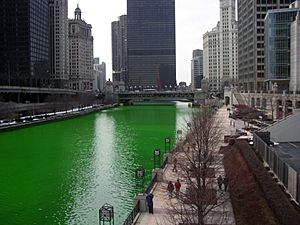
Irish people are one of the largest ethnic groups in Chicago. Neighborhoods like Beverly and Bridgeport have strong Irish-Catholic populations. People from the south side of Chicago who are of Irish heritage are known as the "South Side Irish."
Chicago has many Saint Patrick's Day celebrations. The most famous is dyeing the Chicago River green. Thousands of people watch as a boat releases dye into the river, turning it a bright green color. The Chicago Journeymen Plumbers Union Local 130 sponsors this and knows the secret dye mix!
Another famous celebration is the South Side Irish parade. This parade is more for people of Irish heritage. It features traditional Irish dancers and local groups. There's also a Northwest Side Irish Parade that started in 2004.
The Chicago White Sox baseball team, who play on the South side, have a "Halfway to Saint Patrick's Day" event in September. They wear white jerseys with green pinstripes and caps instead of their usual black. The 2020 parade was canceled because of the coronavirus outbreak.
Cleveland, Ohio
Cleveland has honored its Irish heritage with an annual Saint Patrick's Day parade since 1842. It's Ohio's largest and oldest celebration. The parade always happens on March 17th, no matter the day of the week. It runs along Superior Avenue downtown.
Over 15,000 people march in the parade, and hundreds of thousands watch. In 2012, a new record was set with over 500,000 people attending! Each year, a Grand Marshal is chosen to lead the parade. This is an honorary title for someone who has greatly helped Irish activities in Cleveland.
Columbia, South Carolina
Each year, Saint Patrick's in Five Points welcomes over 40,000 people. The festival includes a 10K and 5K run, a fun parade, family entertainment, Irish food, crafts, and a kids' play area. There are also five outdoor stages with live music and over 25 musical acts.
Dallas, Texas
The city of Dallas, Texas, has held a Saint Patrick's Day parade down Greenville Avenue since 1979. It's the biggest celebration in the city. The parade was almost canceled in 2012 due to costs but was saved by local billionaire Mark Cuban. Like many other cities, their 2020 parade was canceled.
Detroit, Michigan
Saint Patrick's Day was first formally celebrated in Detroit in 1808. The current parade, sponsored by the United Irish Societies, began in 1959. It's held in Detroit's Corktown neighborhood, which is named after its Irish residents who mostly came from County Cork.
Dublin, California
The annual Saint Patrick's Day celebration in Dublin, California, includes a 5K Fun Run and Walk, a pancake breakfast, a festival, and a parade. The parade is very popular. The festival has food, games, rides for kids, arts and crafts, and information about local groups.
Enterprise, Alabama
The "World's Smallest Saint Patrick's Day Parade" happens in Enterprise, Alabama, every year. Only one person, usually dressed in festive Irish clothes and carrying a large Irish flag, is in the parade. They walk one block from the courthouse to the Boll Weevil Monument and back. Local and national news often report on this tiny parade!
Holyoke, Massachusetts
This city in western Massachusetts had many Irish immigrants in the 1800s. It hosts a parade that its organizers say is the second largest in the United States. It's held on the Sunday after Saint Patrick's Day. Over 300,000 people attend, with more than 25,000 marchers. There's also a 10K road race and many other events. Each year, an Irish-American who has done great things in their job receives the John F. Kennedy National Award.
Hot Springs, Arkansas
The Hot Springs, Arkansas, parade is one of the world's shortest! It's held annually on historic Bridge Street, which is called "The Shortest Street in the World" (98 feet long) by Ripley's Believe It or Not!. This makes it perfect for the shortest Saint Patrick's Day parade.
New Orleans
Historically, New Orleans was a major entry point for Irish immigrants in the U.S. South. The city still has a large Irish population. Saint Patrick's Day traditions here go back to the 1800s, with many block parties and parades.
New Orleans parades are often based around neighborhoods and community groups. Major parades include the Irish Channel parade and the Downtown Irish Parade. Like Mardi Gras parades, some floats are reused, and beads and trinkets are thrown to the crowd. New Orleans Saint Patrick's Day parades are also famous for throwing onions, carrots, cabbages, and potatoes, which are ingredients for Irish stew!
New York City
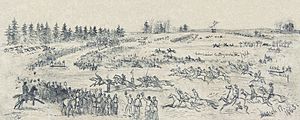
The New York City St. Patrick's Day Parade is the largest Saint Patrick's Day parade in the world and one of the oldest civilian parades. Usually, 150,000 marchers participate, including bands, firefighters, military and police groups, and social clubs. Two million spectators line the streets! The parade marches up 5th Avenue in Manhattan and is always led by the 69th Infantry Regiment (New York). New York politicians often march in the parade.
For many years, the parade did not allow gay groups. On September 3, 2014, the organizers decided to lift the ban. In 2015, OUT@NBCUniversal, a group of gay employees from NBCUniversal, became the first gay group to march. Since 1948, a banner saying "England get out of Ireland" has been carried in the parade.
The first Saint Patrick's Parade in NYC was held in 1762 by the growing Irish community. Some say it was the first recorded Saint Patrick's Parade in the world. As the Irish community grew in the U.S., parade traditions spread to other American cities.
The New York parade is sometimes moved if March 17th falls on a Sunday or during Holy Week (the week before Easter). The parade was put on hold in 2020 due to the COVID-19 pandemic. You can watch the parade live on NBC Channel 4 New York (WNBC). Besides the parade, there are other Saint Patrick's-themed events in the city, like comedy shows and concerts.
Omaha, Nebraska
Omaha's "Stockyards" opened in 1883 and was once the world's largest livestock market. This brought many different groups to the area, including the Irish. The Irish were the third largest ethnic group in South Omaha in the 1900s. Today, the Ancient Order of Hibernians (AOH) parade has over 130 groups and lasts more than 90 minutes. It winds through downtown and the Old Market.
Pearl River, New York
Pearl River attracts over 100,000 people, making it the second largest parade in New York State, after New York City. It's also one of the top 10 parades in the country. The parade started in 1963.
Peoria, Illinois
The St. Patrick Society sponsors a Saint Patrick's Day Parade and Party on March 17th each year. The parade goes through downtown Peoria. Awards are given for different parade groups. The parade ends near a family-focused party with Irish music, dance, and refreshments.
Pittsburgh, Pennsylvania
Saint Patrick's Day in Pittsburgh is known as one of the biggest and best celebrations in the U.S. The parade dates back to 1869. Over 23,000 people march in the parade, and almost 500,000 come to celebrate! The city practically shuts down for the day. Pittsburgh also has a high percentage of Irish people living there.
Philadelphia, Pennsylvania
One of the largest parades in the nation is in Philadelphia, held on the Sunday before Saint Patrick's Day. It began in 1771. Before the first parade, Irish people were already celebrating in Philadelphia. George Washington encouraged his Irish soldiers to celebrate Saint Patrick's Day.
In 2013, the parade had about 20,000 participants in over 150 groups. These included marching bands, youth groups, dancers, and Irish associations. The parade route goes through Central Philadelphia, past Philadelphia City Hall and Independence Hall. All parades since 2020 have been on hold due to the coronavirus outbreak.
Quad Cities, Illinois and Iowa
This group of Midwestern cities has an Irish population that hosts a Saint Patrick's Day parade. It's unique because it's the "only bi-state St. Patrick's Day Parade in the USA." It crosses the Centennial Bridge from Rock Island, Illinois, into Davenport, Iowa. Even though it's near Chicago, this parade still gathers around 200,000 people each year.
Rolla, Missouri
Rolla, Missouri, is home to the Missouri University of Science & Technology, an engineering college. Since Saint Patrick is the patron saint of engineers, the school and town's celebrations start ten days before Saint Patrick's Day. A parade is held downtown the Saturday before. A royal court is crowned, and the streets are painted solid green. Each year's celebrations are called "The Best Ever."
San Diego, California
San Diego's Saint Patrick's Day Parade and Festival is the largest Saint Patrick's Day Parade west of the Mississippi. It lasts two hours and has over 120 groups. The theme for the day is "Celebrating Faith and Freedom." Over 30,000 people enjoy the event, which includes three stages, a Kid's Zone, a Celtic Village, food, crafts, and beer gardens. It's held in Balboa Park. There has been no parade since 2020, like in many cities.
San Francisco, California
There has been a Saint Patrick's Day celebration in San Francisco since 1852. San Francisco has always had a large Irish American population. Each year, Irish people from all over the San Francisco Bay Area come to San Francisco to march in or watch the parade down Market Street. Many people from all ethnic groups wear green in San Francisco on Saint Patrick's Day.
St. Louis, Missouri
The first Saint Patrick's Day celebration in St. Louis was on March 17, 1820. In 1969, Joseph B. McGlynn Jr. started a Saint Patrick's Day Parade downtown. The Irish Prime Minister even marched in the second year of the parade! The celebration has been on hold since 2020.
Savannah, Georgia
One of the largest parades is held in Savannah, Georgia, near Emmet Park. The parade in Savannah is the largest in Georgia. Many Irish people settled in Savannah early on. There is a Mass at the Cathedral Basilica of Saint John the Baptist before the parade. In the 1960s, there was an attempt to dye the Savannah River green, but it only made a green stripe. The parade travels through Savannah's Historic District.
Some people think a private parade was held in Savannah in 1813. Another source says the first celebration was in 1818. However, it's generally agreed that the first public parade was in 1824, organized by the Hibernian Society. The 2012 parade had over 360 groups, making it the largest in Savannah's history. Organizers said the crowd was over a million people! No parades were held from 1861 to 1865, 1917 to 1918, 1942 to 1945, and 2020 to 2021.
Scranton, Pennsylvania
Scranton has a rich history of Saint Patrick's Day festivities. It's one of the oldest parades in the United States, happening annually since 1862. The Saint Patrick's Day Parade Association of Lackawanna County organizes it. The parade has gained national attention for being one of the best.
Seattle, Washington
Seattle, Washington's Saint Patrick's Day Parade is recognized as one of the "Five places to get your green on" in America by CNN. It travels along a 1-mile route through the city's downtown. Seattle's celebration is the largest and oldest in the Northwestern United States. In 2009, about 20,000 spectators and groups came out.
The week-long celebration includes the "Laying 'O the Green," where people mark the parade path with a mile-long green stripe. There's also an Irish Soda Bread Baking Contest, a Mass for Peace, and the annual Irish Week Festival. This festival has step dancing, food, exhibitions, and Irish lessons. Many famous people of Irish descent visit Seattle during this time. The 2020 parade was canceled due to concerns about the coronavirus outbreak.
Syracuse, New York
In Syracuse, New York, Saint Patrick's celebrations traditionally begin with green beer delivered to Coleman's Irish Pub. This pub is in the Tipperary Hill section, which is known for its "Green-on-Top" Traffic Light. Saint Patrick's Day officially starts at midnight with the painting of a Shamrock under this unique traffic light. Syracuse boasts the largest Saint Patrick's Day celebration per person in the U.S. Their annual Syracuse Saint Patrick's Parade draws over 100,000 visitors and 5,000 to 6,000 marchers.
Washington, D.C.
A one-day music festival with a parade called National ShamrockFest has been held in Washington, D.C. each year since 2000. About 40,000 people attend. The Saint Patrick's Parade of Washington, D.C., first held in 1971, runs down Constitution Avenue. It features marching bands, pipe bands, Irish dance schools, and floats. The parade was put on hold in 2020 due to the COVID-19 pandemic.
Worcester, Massachusetts
The Worcester County St. Patrick's Day Parade has been held annually on the Sunday before Saint Patrick's Day since 1983. The parade route runs along Park Avenue. The parade often sees crowds of over 100,000 people.
Sports and Saint Patrick's Day
Baseball
Even though Major League Baseball is in its preseason spring training during Saint Patrick's Day, some teams celebrate with holiday-themed uniforms. The Cincinnati Reds were the first team to wear Saint Patrick's Day hats in 1978. The Philadelphia Phillies were the first to wear green uniforms in 1981, thanks to pitcher Tug McGraw. Many other teams now wear special green jerseys or hats, including the Boston Red Sox, Los Angeles Dodgers, Detroit Tigers, and Chicago White Sox. The White Sox even have a "Halfway to St. Patrick's" promotion in September where they wear green pinstriped uniforms.
Almost all Major League Baseball teams now sell Saint Patrick's Day merchandise, like green hats, jerseys, and T-shirts.
Basketball
Four National Basketball Association teams wear special green jerseys for Saint Patrick's Day week. The Boston Celtics, whose regular road jersey is green, wear their gold/green jerseys. The Chicago Bulls and Toronto Raptors wear their black/green alternate jerseys. The New York Knicks used to wear their green/orange alternate jerseys.
Ice Hockey
The New Jersey Devils of the National Hockey League traditionally wear their old-style uniforms, which include green, on Saint Patrick's Day. The Buffalo Sabres have also worn green and white Irish-inspired practice jerseys. Many minor-league hockey teams also wear special green jerseys for the occasion.
Rugby
The Saint Patrick's Day Test (also known as the Donnybrook Cup) is an international rugby league football match. It's played between the United States and Ireland. This game usually happens around March 17th to celebrate Saint Patrick's Day.





